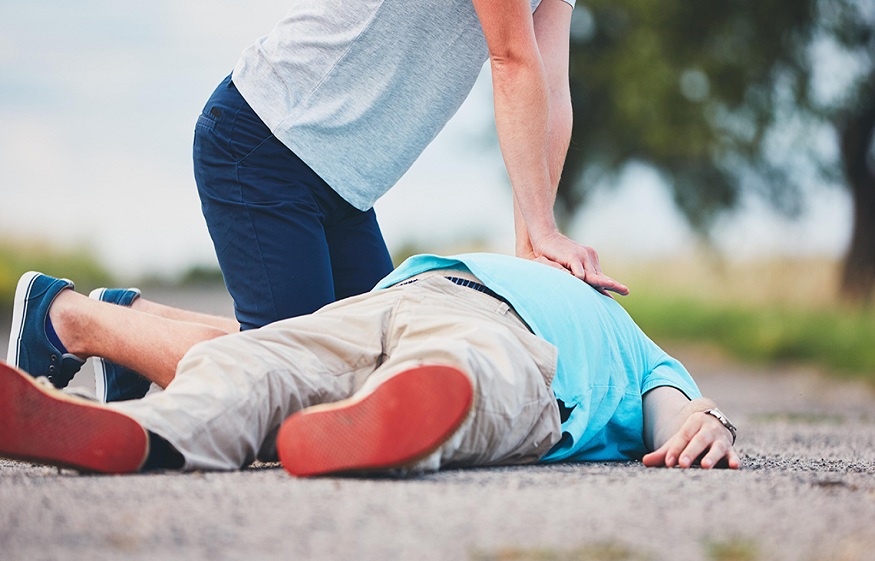When someone around us suffers an accident, a choking with loss of consciousness, or any other event that leaves them without breathing or pulse, it is helpful to know how to perform CPR.
Cardiopulmonary resuscitation (CPR) is a series of techniques or maneuvers aimed to restore breathing and blood circulation to vital organs in cases where the breathing stops suddenly. Therefore, the heart stops beating and lacks a pulse. There are many reasons why a person can suffer a cardiorespiratory arrest (CPA), from a myocardial infarction or other cardiac, neurological, or pulmonary pathologies to drowning, hypothermia, or trauma.
In any case, if the witnesses know how to act correctly and quickly, it is possible to save the life of the affected person, according to the Spanish Council for Cardiopulmonary Resuscitation (CERCP). Suppose the intervention is carried out within the first 3-4 minutes after cardiac arrest.
In that case, The chances of survival of the affected person can be increased by more than 50%, so if the percentage of people capable of performing CPR increases, between 15 and 20% more lives would be saved each year in Europe.
CERCP data also indicate that in Spain, it is estimated that about 50,000 cardiac arrests occur each year –of which 30,000 would occur outside the hospital setting–, which would cause around 45,000 deaths annually. This body also warns that for every minute that the resuscitation of the patient is delayed, their chances of surviving the event decrease by 10%
Types of cardiopulmonary resuscitation
There are two types of CPR:
- Basic CPR: it is the one that the entire population should know and the one that will be explained below. It can be done by anyone and must be done in the first minutes of a cardiorespiratory arrest.
- Advanced CPR: carried out by health workers, requires the effective use of medical instruments and pharmacology. Only trained people are trained to do it.
The main alarm sign is when it is verified that the victim is unconscious. At that moment is when you should ask for close help, but remember that the time to call the health services is to verify the absence of breathing.
How to perform CPR
Emergencies that require essential life support are any in which the affected person is unconscious. We have verified that they are not breathing, such as choking with loss of consciousness, an overdose, an accident.
To effectively carry out cardiopulmonary resuscitation, there are a few steps that we must follow in a specific order. If done correctly, the victim’s chances of survival will go up dramatically. Therefore, it is convenient for any citizen to know how to do it:
1st) Verify the victim’s condition
The first step is to stimulate the victim to see if he is unconscious. To do this, he will be placed on his back, and we can give him a few blows on the shoulders and speak in his ear to see if with this he moves, opens his eyes, or makes a sound that indicates that he regains consciousness. If he does not respond, he may be in cardiorespiratory arrest, but we must ask for help before confirming it.
2nd) Ask for help
An unconscious person is a cause for alarm, so we will look around for someone who can help us. It can be yelling or calling a house if we are on the street. Of course, you should never abandon the victim. Once we confirm the absence of breathing, the health services will be called.
3rd) Release the airway (forehead-chin maneuver):
The victim, during a stop, has all the muscles relaxed, which causes the tongue to fall backward, covering the windpipe and preventing air from entering or leaving.
Therefore, the third step is to ensure the airway, that is, that the throat is free so that air can quickly enter and exit the lungs. To do this, the person will be held with one hand on the forehead and the other on the chin, and the head will be moved entirely back so that the chin goes up. With this maneuver, we will be able to clear the throat.
4th) Search for breath (see, hear and feel)
With the forehead chin maneuver, the rescuer should bring the ear close to the victim’s mouth. In this way, three senses are involved (sight, hearing, and touch) to check if you breathe:
- It is observed if the victim’s chest rises and falls when living.
- Listen for breath sounds, air entering, and exiting.
- The heat of the air is felt as it is expelled from the victim’s mouth.
It is not necessary to check the pulse, if the fault is in the heart, it will not have a beat, and that will have been the cause of the absence of respiration. If the failure has been respiratory and the person does not ventilate, after a few minutes, the pulse will stop. Right from the start, if there are no breaths, we will act as if there are no beats either.
5th) Call emergencies
Therefore, if the person is unconscious and out of breath, the emergency services (112) must automatically be called. The situation communicated clearly and, explaining the location so that they can easily find you.
When CPR begins: the rescuer should initiate resuscitation with 30 external chest compressions followed by two artificial ventilations.
6th) Perform chest compressions
To carry them out, we place our hands as follows: the dominant hand (either left or right) open and the other on top, with interlaced fingers, and placed on the chest approximately between the nipples (in the center of the thorax). The rescuer then, with his elbows fully extended, lets his entire weight fall on his hands in one intense, rapid motion.
If the compressions are done correctly, a small amount of oxygen reaches the brain and the heart, enough to maintain the body until the intervention of the medical team. To be effective, compressions must meet specific requirements:
- That the frequency is more significant than 100 beats per minute.
- Let the victim’s chest sink between 4 and 5 centimeters.
- Once compression is finished, the chest must be allowed to re-expand before the next compression.
- Do not stop resuscitation unless the victim recovers, the health services take over, or the rescuer (if alone) is completely exhausted and unable to continue.
After the 30 chest compressions, two artificial ventilation are given. It is always that ratio: 30 compressions – 2 ventilations, regardless of the rescuers. If there are more than one, the ideal is that they take turns.
7th) Mouth-to-mouth ventilation
Artificial ventilation is performed with the fore-chin maneuver to open the airway and to cover the nose so that the air that is breathed in does not escape. The rescuer takes a normal inspiration and places his mouth on the victim’s, taking care to seal it completely, and expels the air to reach the lungs. As you ventilate, see if the victim’s chest rises. If the chest swells, insufflations are effective. Two ventilations are given for every 30 chest compressions.
What not to do in CPR
- Do not interrupt the technique. If there is more than one rescuer, it is recommended that they change every two minutes to avoid fatigue.
- Never abandon the victim.
- The victim may have vomiting, or poor oral hygiene is observed. In these cases, only chest compressions are continued, although ventilation should be performed whenever possible.
- If, when performing mouth-to-mouth, not all the air enters (it may be that the lips are not completely sealed), do not do it again.

